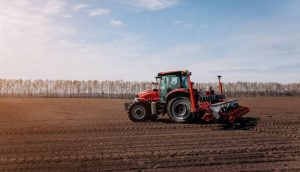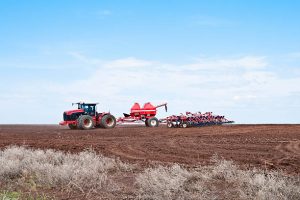Are you a farmer looking to revolutionize your farming practices? Look no further than the ultimate guide to grain drill seed cups. These small but mighty tools are essential for planting seeds efficiently and precisely, saving you valuable time and resources.
With the right grain drill seed cup, you can ensure accurate seed placement, optimal seed-to-soil contact, and even seed distribution, ultimately leading to higher crop yields. Whether you’re a seasoned farmer or a novice, this comprehensive guide will walk you through everything you need to know about grain drill seed cups, from understanding the different types available to selecting the right one for your specific needs.
Discover the benefits of using grain drill seed cups in your farming operations, including increased efficiency, improved seed germination rates, and reduced seed waste. Explore the different features and functionalities offered by various brands, ensuring you make an informed decision when investing in this crucial farming tool. Get ready to take your farming to the next level and achieve greater success with the help of grain drill seed cups.
Understanding the importance of grain drill seed cups in farming
Grain drill seed cups play a vital role in modern farming practices. They are designed to accurately meter and deliver seeds into the soil, ensuring precise seed placement and optimal seed-to-soil contact. This is crucial for promoting seed germination and maximizing crop yields.
One of the key benefits of using grain drill seed cups is the ability to achieve consistent seed spacing. This is essential for uniform plant growth, as uneven spacing can lead to competition for resources and reduced crop productivity. Grain drill seed cups ensure that each seed is placed at the right distance from its neighboring seeds, creating an ideal environment for plants to thrive.
In addition, grain drill seed cups help to reduce seed waste. By accurately metering and delivering seeds, farmers can avoid over-seeding or under-seeding, both of which can result in inefficient resource utilization and lower crop yields. With grain drill seed cups, farmers can achieve optimal seed distribution, maximizing the potential of each seed and minimizing waste.
Different types of grain drill seed cups
When it comes to grain drill seed cups, there are several types available, each with its own unique features and functionalities. Understanding the different types can help you decide when to select the right grain drill seed cup for your specific needs.
1. Fluted Seed Cups:
Fluted seed cups are the most common type of grain drill seed cups. They feature spiral grooves on the inside, which help to guide and meter the seeds as they are being delivered. Fluted seed cups are versatile and can handle a wide range of seed sizes, making them suitable for various crops.
2. Cell-Type Seed Cups:
Cell-type seed cups are designed with individual cells or compartments, each capable of holding a single seed. This type of seed cup offers precise seed placement and spacing, making it ideal for crops that require uniform plant growth, such as vegetables or specialty crops.
3. Air-Assisted Seed Cups:
Air-assisted seed cups use a combination of air pressure and vacuum to deliver seeds. This technology allows for precise seed placement, even in challenging conditions, such as high residue or uneven terrain. Air-assisted seed cups are particularly beneficial for no-till or minimum-tillage farming systems.
Factors to consider when choosing grain drill seed cups
Selecting the right grain drill seed cups for your farming operation is crucial for achieving optimal results. Here are some key factors to consider when making your decision:
1. Seed Size Compatibility:
Different grain drill seed cups are designed to handle specific seed sizes. It is important to choose a seed cup that is compatible with the size of the seeds you will be planting. Using the wrong seed cup can result in inaccurate seed placement and poor seed-to-soil contact.
2. Durability and Longevity:
Grain drill seed cups are subjected to significant wear and tear during planting operations. Look for seed cups made from high-quality materials that can withstand the rigors of farming. Consider factors such as resistance to corrosion, abrasion, and impact.
3. Ease of Installation and Maintenance:
Opt for grain drill seed cups that are easy to install and maintain. Look for features such as quick-release mechanisms or tool-less adjustments, as these can save you valuable time and effort. Additionally, consider the availability of replacement parts and the manufacturer’s reputation for customer support.
4. Compatibility with Your Equipment:
Ensure that the grain drill seed cups you choose are compatible with your existing equipment. Consider factors such as mounting options, drive systems, and compatibility with other components, such as seed tubes or fertilizer attachments.
5. Price and Value for Money:
While price is an important consideration, it should not be the sole determining factor. Look for grain drill seed cups that offer good value for money, considering factors such as durability, performance, and the manufacturer’s reputation.
How to properly install and maintain grain drill seed cups
Proper installation and maintenance of grain drill seed cups are essential for optimal performance and longevity. Here are some tips to ensure you get the most out of your seed cups:
1. Read the Manufacturer’s Instructions:
Before installing your grain drill seed cups, carefully read the manufacturer’s instructions. These instructions will provide specific guidance on installation procedures, proper adjustment, and any additional requirements for your specific seed cups.
2. Clean and Inspect:
Before each planting season, thoroughly clean your seed cups and inspect them for any signs of damage or wear. Remove any debris or residue that may have accumulated, as this can affect seed metering and delivery.
3. Lubricate Moving Parts:
Apply a suitable lubricant to any moving parts of your seed cups, such as bearings or bushings. This will help reduce friction and wear, ensuring smooth operation and extending the lifespan of your seed cups.
4. Check Calibration:
Regularly check the calibration of your seed cups to ensure accurate seed metering. This can be done by counting the number of seeds delivered by a specific distance or using calibration tools provided by the manufacturer.
5. Replace Worn or Damaged Parts:
If you notice any worn or damaged parts during your inspections, replace them immediately. Continuing to use compromised seed cups can result in inaccurate seed placement and reduced performance.
Tips for maximizing the efficiency of grain drill seed cups
To get the most out of your grain drill seed cups and optimize your farming efficiency, consider the following tips:
1. Plan Your Planting Schedule:
Properly plan your planting schedule to optimize the use of your grain drill seed cups. Consider factors such as weather conditions, soil moisture, and crop rotation. By planting at the right time, you can ensure optimal seed germination and maximize crop yields.
2. Calibrate for Seed Variability:
If planting seeds with varying sizes or shapes, consider calibrating your seed cups accordingly. Some seed cups offer adjustable settings to accommodate different seed types. Ensuring accurate seed metering for each seed type can help promote uniform plant growth.
3. Monitor and Adjust Seed Depth:
Regularly monitor the depth at which your seeds are being planted. Adjust the seed depth settings on your grain drill as needed to ensure optimal seed-to-soil contact. Deep planting can result in slow or uneven germination, while shallow planting can expose seeds to unfavorable environmental conditions.
4. Practice Proper Maintenance:
Follow the manufacturer’s recommendations for the maintenance and servicing of your grain drill. Regularly inspect and clean seed delivery tubes, seed agitators, and other components that can affect seed metering and delivery. Proper maintenance will help ensure consistent and accurate seed placement.
5. Keep Records and Evaluate Performance:
Keep detailed records of your planting operations, including seed type, seed rate, and planting depth. Periodically evaluate the performance of your grain drill seed cups by measuring crop emergence and yield. This data will help you identify any areas for improvement and make informed decisions for future planting seasons.
Common issues and troubleshooting techniques for grain drill seed cups
While grain drill seed cups are reliable tools, occasional issues may arise. Here are some common issues you may encounter and troubleshooting techniques to address them:
1. Uneven Seed Spacing:
If you notice uneven seed spacing, check for worn or damaged seed cups. Replace any worn or damaged seed cups and recalibrate if necessary. Also, ensure that the seed cups are properly adjusted and that there are no obstructions, such as debris or clumps of soil, interfering with the seed delivery.
2. Seed Skipping or Double Planting:
If seeds are skipping or double planting, check for obstructions in the seed delivery system, such as clogged seed tubes or worn seed agitators. Clean or replace any damaged components and ensure that the seed cups are properly adjusted for accurate seed metering.
3. Inconsistent Seed Depth:
Inconsistent seed depth can be caused by improper adjustment or worn seed cups. Check the seed depth settings on your grain drill and adjust as needed. Also, inspect the seed cups for any signs of wear or damage and replace them if necessary.
4. Seed Bridging or Clumping:
Seed bridging or clumping can occur if the seed cups are not properly calibrated or if the seed delivery system is not clean. Ensure that the seed cups are calibrated for the specific seed size and type you are planting. Regularly clean the seed delivery tubes and agitators to prevent seed buildup.
5. Excessive Seed Waste:
Excessive seed waste can result from over-seeding or poor seed metering. Check the calibration of your seed cups and ensure that they are delivering the desired seed rate. If necessary, recalibrate the seed cups or adjust the seed rate settings on your grain drill.
Upgrading to advanced grain drill seed cup technology
Advancements in grain drill seed cup technology have brought about significant improvements in seed placement accuracy and overall farming efficiency. Consider upgrading to advanced grain drill seed cup technology to further enhance your farming operations. Here are some notable advancements:
1. Precision Metering Systems:
Precision metering systems use advanced sensors and software algorithms to precisely measure and deliver seeds. These systems offer superior seed placement accuracy, even at high planting speeds, and can adapt to varying field conditions.
2. Variable Rate Technology:
Variable rate technology allows for the precise adjustment of seed rates based on field conditions, soil types, or crop requirements. By varying the seed rate within a single field, farmers can optimize seed placement and maximize crop yields.
3. Real-Time Monitoring and Control:
Some advanced grain drill seed cups offer real-time monitoring and control capabilities. This allows farmers to monitor seed delivery rates, seed spacing, and other parameters during planting operations. Real-time adjustments can be made to optimize seed placement and address any issues immediately.
4. Integrated Data Management:
Advanced grain drill seed cups can integrate with farm management software, allowing for seamless data collection and analysis. This data can be used to monitor and evaluate planting performance, optimize seed-to-soil contact, and make informed decisions for future planting operations.
Case studies and success stories of farmers who have benefited from grain drill seed cups
Many farmers have experienced significant benefits from using grain drill seed cups in their farming operations. Here are some case studies and success stories that highlight the positive impact of grain drill seed cups:
1. John’s Story:
John, a corn farmer, invested in a precision metering system for his grain drill. By accurately placing seeds at the desired spacing and depth, John achieved higher germination rates and uniform plant growth. This resulted in a significant increase in his corn yields, ultimately leading to higher profits.
2. Sarah’s Success:
Sarah, a vegetable farmer, upgraded to cell-type seed cups for her grain drill. The precise seed placement and spacing provided by these seed cups improved the overall quality and uniformity of her vegetable crops. Sarah’s customers noticed the difference and she was able to command higher prices for her produce.
3. Mark’s Efficiency Boost:
Mark, a soybean farmer, switched to air-assisted seed cups for his grain drill. The air-assisted technology allowed him to plant soybeans in high residue conditions without compromising seed placement accuracy. This saved him valuable time and reduced the need for additional field operations, resulting in improved farming efficiency.
These case studies and success stories demonstrate the transformative power of grain drill seed cups in farming operations. By embracing this technology, farmers can achieve higher yields, reduce seed waste, and optimize their overall farming efficiency.
Conclusion: Embracing the future of farming with grain drill seed cups
Grain drill seed cups have revolutionized farming practices, enabling farmers to achieve precise seed placement, optimal seed-to-soil contact, and efficient seed distribution. By using the right grain drill seed cups for their specific needs, farmers can experience increased efficiency, improved seed germination rates, and reduced seed waste.
Understanding the different types of grain drill seed cups and considering factors such as seed size compatibility, durability, ease of installation and maintenance, and compatibility with existing equipment, will help farmers make informed decisions when selecting grain drill seed cups.
Proper installation, maintenance, and calibration of grain drill seed cups are essential for optimal performance. By following recommended procedures and regularly inspecting and cleaning seed cups, farmers can ensure consistent and accurate seed placement.
Maximizing the efficiency of grain drill seed cups involves proper planning, calibration for seed variability, monitoring and adjusting seed depth, practicing proper maintenance, and keeping records to evaluate performance and identify areas for improvement.
In case issues arise, farmers can troubleshoot common problems such as uneven seed spacing, seed skipping or double planting, inconsistent seed depth, seed bridging or clumping, and excessive seed waste.
For those looking to embrace advanced technology, upgrading to precision metering systems, variable rate technology, real-time monitoring and control, and integrated data management can further optimize farming operations.
By learning from the success stories of farmers who have benefited from grain drill seed cups, farmers can gain insights into the potential improvements in crop yields, quality, and overall farming efficiency.
In conclusion, grain drill seed cups are indispensable tools for farmers looking to revolutionize their farming practices. Embracing this technology and harnessing its benefits will undoubtedly lead to greater success in farming operations. So, why wait? Start revolutionizing your farming with grain drill seed cups today!





